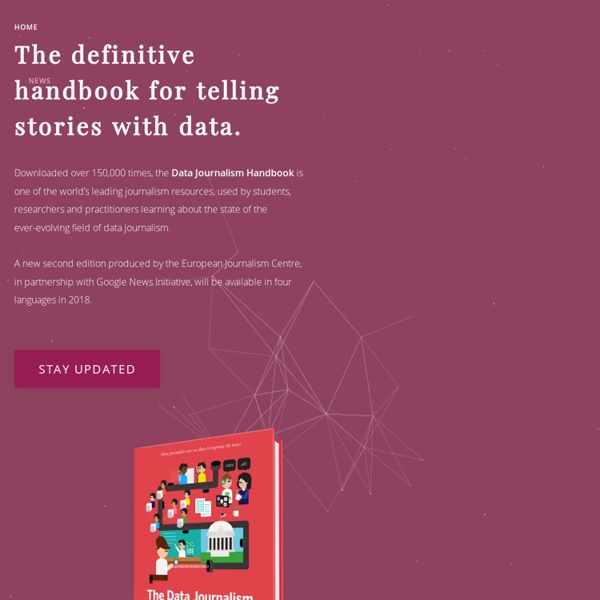



http://datajournalismhandbook.org/
Related: JournalismUn état des lieux de l’Open Data David Eaves, conseiller auprès de plusieurs institutions pour l'ouverture des données, a profité de son discours inaugural à l'Open Data Camp 2011 de Varsovie pour dresser un bilan, et évoquer des pistes pour l'avenir. Où en est l’Open Data ? Au cours de mon récent discours d’inauguration à l’Open Data Camp (qui se tenait cette année à Varsovie), j’ai tenté de poursuivre l’intervention que j’avais faite lors de la conférence de l’an passé. Data Journalisme ou Journalisme de Données Got it! Ce site utilise des cookies pour vous assurer une meilleure expérience Cookie Consent plugin for the EU cookie law Accueil > Data Journalisme ou Journalisme de Données Data Journalisme ou Journalisme de Données
Convaincre avec des graphiques efficaces Uploaded on Convaincre avec des graphiques efficaces : Data visualisation Théorie, Méthode & Bonnes pratiques ... Convaincre avec des graphiques efficaces : Data visualisation Théorie, Méthode & Bonnes pratiques Bernard Lebelle (2ème édition - Eyrolles) ----- Représenter visuellement l'information est le moyen le plus sûr de transmettre un sujet complexe. Dans un monde où le temps d'attention est limité, il est nécessaire de développer des graphiques clairs et efficaces capables de porter votre message.
Les pouvoirs publics en tant que plate-forme de services Il est temps de créer plusieurs applications phares en matière e-gouvernementale, estime Vincent Van Quickenborne. "Le nuage est une étape essentielle", a-t-il affirmé, dans le discours qu’il a prononcé lors de la conférence 'Lift-off towards Open Government' à Bruxelles. Le ministre de l’ICT sortant, Vincent Van Quickenborne, a soutenu en grande partie le plan d’action dans le domaine e-gouvernemental présenté par la commissaire européenne Neelie Kroes, où l’un des mots-clés est 'open data'. 2 ans de datajournalisme vus par le Guardian Premier média au monde à se mettre au data journalisme, le quotidien britannique The Guardian revient sur ses deux ans d’expérience et les leçons à en tirer. Tous les liens de l’article sont en anglais. Voilà une information intéressante : le data journalisme a désormais gagné ses lettres de noblesse. Pas à la manière de l’élite d’Oxbridge (bien qu’il y ait des données là-dessus), mais plutôt en devenant une norme de l’industrie. Il y a deux ans, quand nous avons lancé le Datablog, tout ça était nouveau.
La facilitation graphique et le design de l'information Nous aidons les entreprises à faciliter et à accélérer le traitement des informations complexes pour les rendre explicites. Le design de l’information nous aide à simplifier ce qui peut paraître complexe et rendre explicite ce qui peut nous sembler abstrait ! Le design de l’information est le résultat produit entre la préparation d’une information et son traitement graphique. Une certaine idée de l’open data Le 13 juillet dernier est sorti un rapport produit par 4 élèves de l'école des Ponts ParisTech, intitulé "Pour une politique ambitieuse des données publiques". Il résume parfaitement une certaine idée de l'Open Data. L’open data est à la mode.
5 questions à 6 datajournalistes Ils sont datajournalistes et travaillent pour le le site du Guardian, Owni, Lemonde.fr, AskMédia ou J++. Leur point commun : ils sont jeunes et ils ont un goût immodéré pour les données qu’ils aiment manipuler et décortiquer. Ces ventriloques de la data font parler chiffres et statistiques dans leurs articles, leurs applications ou leurs visualisations. Atelier data visualisation une image vaut mieux qu'un long discours Atelier du 18 juin 2014 du Pôle Numérique de la CCI Bordeaux avec le témoignage de 10H11 : Atelier "Data visualisation une image vaut mieux qu'un long discours; Communiquez visuellement avec vos ... Atelier du 18 juin 2014 du Pôle Numérique de la CCI Bordeaux avec le témoignage de 10H11 : Atelier "Data visualisation une image vaut mieux qu'un long discours; Communiquez visuellement avec vos données". La visualisation de données ou data visualisation ce n'est pas un outil à la mode : c'est efficace !
Les États s’ouvrent "Open government". Comment et quels États ouvrent d'eux-mêmes leurs données publiques ? Ceux qui combattent la corruption, qui ont une expérience récente de la dictature et ceux qui le font par conviction ou tradition. Le mouvement d’ouverture des données est lancé. L’open data se diffuse après les campagnes lancées par les pionniers, comme Michael Cross, dès 2006. Data Visualisation ou l’art de se faire comprendre De nos jours il faut comprendre et se faire comprendre vite et bien. Une bonne présentation, un bon article ou bien un bon poster se distingue non seulement par un contenu pertinent mais aussi par des illustrations efficaces. On peut avoir la meilleure idée du monde, si on ne sait pas la mettre en valeur elle peut tout simplement passer à la trappe.
Open data: ouvre-t-on l'accès aux données publiques en Belgique? Du travail des administrations publiques ressortent toute une série d’informations et de données statistiques. Ces données publiques pourraient permettre de répondre à des questions très concrètes : comment les gouvernements dépensent-t-ils leurs budgets? Combien d’entreprises ont été créées sur l’année écoulée et dans quels secteurs? Quels services aux personnes pourraient être mis sur pied et où ? Un enjeu à la fois citoyen et entrepreneurial